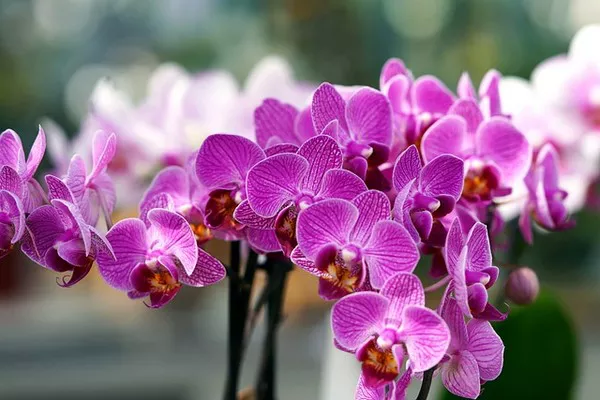Orchids are beloved for their exotic beauty and delicate blooms, but getting them to rebloom can sometimes be a challenge for even experienced gardeners. If you’ve found yourself struggling to coax your orchid into flowering again, fear not. With the right care and attention, you can encourage your orchid to rebloom and enjoy its stunning flowers year after year.
Understanding Your Orchid
Before diving into the specifics of encouraging your orchid to rebloom, it’s important to understand the basic needs of these fascinating plants. Orchids are a diverse family of flowering plants, with thousands of species and hybrids available to home gardeners. While they vary widely in appearance and requirements, most orchids share some common characteristics.
First and foremost, orchids are epiphytes, meaning they naturally grow on trees or other plants in their native habitats. This unique growth habit has led to some specific care requirements, particularly when it comes to watering and potting media. Most orchids prefer a loose, well-draining potting mix that mimics the airy conditions of their natural environment.
In addition to their growing medium, orchids also require ample light to thrive. While some species prefer bright, indirect light, others can tolerate more direct sunlight. Understanding the light preferences of your specific orchid is crucial for providing the optimal growing conditions.
Finally, orchids have specific temperature and humidity requirements that can vary depending on the species. While some orchids prefer warm, tropical conditions, others thrive in cooler environments. Maintaining the appropriate temperature and humidity levels is essential for keeping your orchid healthy and promoting blooming.
The Importance of Proper Care
Before focusing on encouraging your orchid to rebloom, it’s essential to ensure that it’s receiving proper care year-round. Consistent care and attention will help keep your orchid healthy and increase the likelihood of it flowering again.
One of the most critical aspects of orchid care is watering. Orchids should be watered thoroughly but allowed to dry out between waterings to prevent root rot. Additionally, it’s essential to avoid getting water on the orchid’s leaves or crown, as this can lead to fungal infections.
In addition to watering, orchids benefit from regular fertilization during the growing season. A balanced orchid fertilizer can help provide the nutrients necessary for healthy growth and flowering. However, it’s important not to over-fertilize, as this can damage the orchid’s roots.
Proper lighting is also crucial for orchid health and blooming. Most orchids prefer bright, indirect light, but it’s essential to avoid exposing them to direct sunlight, which can scorch their leaves. If you’re unsure about your orchid’s light requirements, observe its growth and adjust its placement accordingly.
Finally, maintaining the right temperature and humidity levels is essential for orchid health. While specific requirements vary depending on the species, most orchids prefer temperatures between 60 and 80 degrees Fahrenheit and humidity levels between 40% and 60%. Using a humidity tray or humidifier can help create the ideal growing environment for your orchid.
Encouraging Your Orchid to Rebloom
Once you’ve established a solid care routine for your orchid, you can begin focusing on encouraging it to rebloom. While the process may take some time and patience, following these tips can help increase your orchid’s chances of flowering again.
1. Provide Adequate Light: Orchids require sufficient light to produce blooms, so make sure your orchid is receiving the right amount of light for its species. If necessary, consider supplementing natural light with artificial grow lights to ensure optimal conditions.
2. Mimic Seasonal Changes: Many orchids require a period of cooler temperatures or reduced daylight to initiate blooming. Mimic these seasonal changes by gradually reducing watering and adjusting temperature and light levels to simulate the changing seasons.
3. Prune and Repot: Pruning old flower spikes and repotting your orchid can stimulate new growth and encourage blooming. When repotting, make sure to use a fresh potting mix and provide adequate drainage to prevent waterlogged roots.
4. Provide Adequate Nutrition: Orchids need sufficient nutrients to support blooming, so continue fertilizing regularly during the growing season. However, reduce or stop fertilizing once flower spikes begin to develop to avoid overstimulating vegetative growth.
5. Be Patient: Encouraging an orchid to rebloom can take time, so be patient and consistent with your care routine. With proper attention and care, your orchid will reward you with beautiful blooms in due time.
Common Challenges and Troubleshooting Tips
Despite your best efforts, your orchid may still encounter some challenges along the way. Here are some common issues you may encounter when trying to encourage your orchid to rebloom, along with tips for troubleshooting:
1. Root Rot: Overwatering is a common cause of root rot in orchids, which can prevent them from blooming. If you suspect root rot, carefully inspect your orchid’s roots and repot it in fresh, well-draining media if necessary.
2. Pest Infestations: Orchids are susceptible to pest infestations, such as aphids, mealybugs, and spider mites, which can damage foliage and inhibit blooming. Treat infestations promptly with insecticidal soap or neem oil to prevent further damage.
3. Insufficient Light: If your orchid isn’t receiving enough light, it may fail to produce blooms. Move your orchid to a brighter location or supplement natural light with artificial grow lights to ensure adequate light levels.
4. Improper Temperature or Humidity: Orchids have specific temperature and humidity requirements, so monitor these conditions closely to ensure optimal growth and blooming. Using a thermometer and hygrometer can help you maintain the ideal environment for your orchid.
Conclusion
Encouraging your orchid to rebloom may require some patience and experimentation, but with proper care and attention, you can enjoy its beautiful flowers year after year. By understanding your orchid’s specific needs and providing the right growing conditions, you can increase its chances of blooming and create a stunning display of color and beauty in your home or garden.


